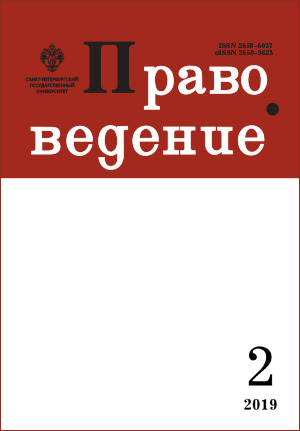Setting constitutional boundaries on institutional reforms in China
DOI:
https://doi.org/10.21638/spbu25.2019.204Abstract
China has experienced dramatic social transformation over the past 40 years of reform and opening up. While achieving tremendous economic achievements, China is also facing a series of challenges due to the complexity of social governance. Advancement among state institutions reform of China since 2014 is part of the aforementioned social transformation process. The institutional reform involves changes in the powers of the legislature, executive and judicial organs, which promotes the formation of a new state organ system and directly leads to the 2018 constitutional amendment. The issue of constitutional limits for the reform of state institutions has aroused widespread concern in academia. The Constitution contains various regulatory bases for institutional reforms. Some of the reforms are clearly bound by the Constitution, some are restricted by its general provisions, and some transcend the framework of power distribution defined in the Constitution. In practice, institutional reforms involve three strategies in response to the Constitution. First, compliance with the Constitution. Second, deviation from the Constitution and promotion of constitutional amendments. Third, deviation from the Constitution with avoidance of constitutional adjustment. This article holds the view that over the course of social transformation, reforms have to remain current while improving the Constitution. Nevertheless, the Constitution that provides the authoritative structure and stable expectation for the state and its citizens shall not be neglected. Any major systemic reform with regard to the Constitution must adhere to formal constitutionality as the primary foundation.
Keywords:
institutional reforms, constitutional amendment, formal constitutionality, institutional transformation
Downloads
References
References
A, Ji. 2015. Authorizing the Reform by the NPC Requires Both Authorization and Supervision. Renmin zhi you 11: 58. (In Chinese)
Chen, Dong. 2017. Control Commission Setup vs. Procuratorial Power Reconstruction. Shoudu shifan daxue xuebao (shehui kexue ban) 2: 58–66. (In Chinese)
Cong, Wensheng. 2014. Constitutional Considerations on the Establishment of the National Security Council. Guofang 11: 64–68. (In Chinese)
Chen, Jinzhao. 2012. The Risk and Correction of Substantive Legal Thinking. Qinghua faxue 4: 66– 89. (In Chinese)
Gao, Quanxi. 2012. Revolution, Reform and Constitution: the 1982 Constitution and its development logic. Zhongwai faxue 5: 907–926. (In Chinese)
Jiang, Guohua. 2013. Substantive Constitutionalism: A Review of the Development of China’s Constitution in the Past Thirty Years. Zhongguo faxue 4: 180–190. (In Chinese)
Ji, Yaguang. 2017. The Historical Development of China’s National Administrative Supervision System. Zhongguo dangzheng ganbu luntan 2: 24–28. (In Chinese)
Liu, Shude. 2013. Constitutional Expression on the Establishment of the Courts. Renmin fayuan bao November 11. (In Chinese)
Long, Zongzhi. 1999. On the Nature of Procuratorial Power and the Reform of Procuratorial Organs. Faxue 10: 2–7 & 22. (In Chinese)
Ma, Huaide. 2017. Legislative Ideas and Key Points of the State Supervision Law. Huanqiu falv pinglun 39 (2): 5–16. (In Chinese)
Ma, Ling. 2015. A Constitutional Perspective on the Establishment of the National Security Council. Yunnan daxue xuebao (Faxue ban) 1: 2–6. (In Chinese)
Ma, Ling. 2015. Discussion of the Legal Status of the National Security Council. Shanghai zheng fa xueyuan xuebao (Fa zhi luncong) 1: 1–8. (In Chinese)
Tushnet, Mark. 2010. Why the Constitution Matters. Yale University Press.
Qin, Qianhong. 2017. Discussion on the Relationship between the Authorization of the NPC Standing Committee and the NPC. Zhongguo falv pinglun 2: 24–31. (In Chinese)
Wan, Yi. 2008. Research on Some Basic Theoretical Problems of Procuratorial Power. Zheng fa luntan 3: 91–106. (In Chinese)
Wang, Zhaoguo. 2004. A Statement on the Draft Amendment of the Constitution of the People’s Republic of China (At the 2nd Session of the 10th National People’s Congress on March 8, 2004). Available at: http://www.npc.gov.cn/zgrdw/npc/oldarchives/zht/zgrdw/common/zw.jsp@label=wxzlk&id=329508&pdmc=1504.htm (accessed: 25.05.2020). (In Chinese)
Xie, Pengcheng. 2000. On the Nature of Procuratorial Power. Faxue 2: 15–18. (In Chinese)
Xiong, Qiuhong. 2012. Comparative Study on Investigating Power of Duty Crime in the Reform of Supervision System. Huanqiu falv pinglun 39 (2): 40–60. (In Chinese)
Yao, Jianzong. 2014. The Concept of Legal Practice in Chinese Context. Zhongguo shehui kexue 6: 141–162 & 209. (In Chinese)
Zhai, Guoqiang. 2016. How to Set up People’s Court across Administrative Division? — From the Constitutional Interpretation Perspective. Fa shang yanjiu 5: 3–9. (In Chinese)
Zheng, Lei. 2017. The Outline of Amending the Constitution for the Reform of the State Supervision System. Huanqiu falv pinglun 39 (2): 132–136. (In Chinese)
Zhu, Fuhui. 2004. The 1954 Constitution and Formation and Innovation of National Ins titution System. Zhongguo Faxue 4: 48–59. (In Chinese)
Downloads
Published
How to Cite
Issue
Section
License
Articles of "Pravovedenie" are open access distributed under the terms of the License Agreement with Saint Petersburg State University, which permits to the authors unrestricted distribution and self-archiving free of charge.




